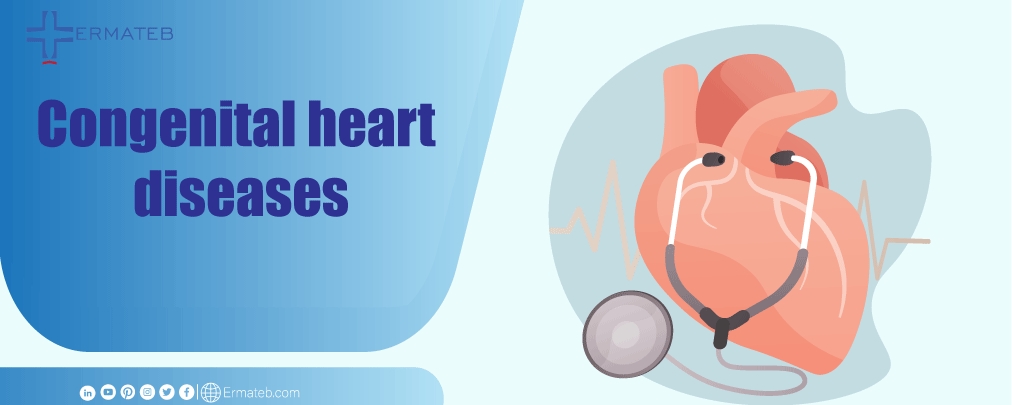
Congenital heart diseases which are also known as CHDs are one of the most common types of birth defects. Nowadays with novel medications, babies have a better chance for longer living and the quality of their lives has been improved. In this article, we tried to discuss the most common congenital heart diseases. After reading the article ask Ermateb's professional experts all of your questions.
All heart defects which are present at birth and are effective in the heart's function and its structure are known as congenital heart diseases. There are different degrees of congenital heart diseases from mild which is a small hole in the heart septum to severe like poorly formed parts of the heart structure. According to statistics about one in four newborns has a heart defect. Based on the grade of their defect they may need surgery or other procedures in the first year of life.
These are types of congenital heart defects and the ones which are marked with a star are critical CHDs.
Atrial Septal Defect
Atrioventricular Septal Defect
Coarctation of the Aorta*
Double-outlet Right Ventricle*
d-Transposition of the Great Arteries*
Ebstein Anomaly*
Hypoplastic Left Heart Syndrome*
Interrupted Aortic Arch*
Pulmonary Atresia*
Single Ventricle*
Tetralogy of Fallot*
Total Anomalous Pulmonary Venous Return*
Tricuspid Atresia*
Truncus Arteriosus*
Ventricular Septal Defect*
As it was explained there are different types of CHDs so the signs and symptoms depend on the severity and the type of disease. Although it's possible to see no sign or symptom in some of the patients there are some common symptoms that you can check following:
Signs and symptoms for CHDs depend on the type and severity of the particular defect. Some defects might have few or no signs or symptoms. Others might cause a baby to have the following symptoms:
Fast or troubled breathing
Sleepiness
rapid heartbeat.
swelling of the legs, tummy, or around the eyes.
a blue tinge to the skin or lips (cyanosis)
tiredness and rapid breathing when a baby is feeding.
Chest pain, chest tightness, chest pressure, and chest discomfort (angina)
Shortness of breath.
Pain, numbness, weakness, or coldness in your legs or arms if the blood vessels in those parts of your body are narrowed.
Pain in the neck, jaw, throat, upper abdomen, or back.
Some of these conditions can be diagnosed at the time of pregnancy easily by using ultrasound which is known as a fetal echocardiogram. Ultrasound waves create pictures from the developing heart. However it is possible to diagnose some of CHDs in pregnancy, some are not detected until after birth or later in life. In some patients, symptoms are appearing in adulthood. If a doctor suspects a CHD may be present in the newborn, the baby can get several tests (such as an echocardiogram) to confirm the diagnosis and start up the treatment procedures.
The treatment procedures depend on the case condition, type of defect, the severity of the symptoms, and ...
In some patients, one or more surgeries will be done to repair the heart or blood vessel defects. Some of the CHDs are very mild and no need to have surgery. Not all CHDs need open-heart surgeries, some can be treated by minimally invasive procedures called cardiac catheterization. During the catheterization, a long tube or catheter is sent to the heart from blood vessels and the doctor is able for taking pictures, measuring the necessary data, or even repairing the defect. Not all defects can be solved completely, sometimes surgeries are done just to improve the blood flow in order to increase the quality of a patient's life and they're not cured completely.
Seizure disorder and the need to take antiseizure medicines
Taking lithium to treat depression
Having phenylketonuria (PKU) and not staying on the special PKU diet during pregnancy
Insulin-dependent diabetes, especially if blood sugar is not well-controlled
Lupus
A connective tissue disorder
A pregnancy from assisted reproductive technology (ART)
Your genes. Congenital heart disease appears to run in families (inherited) and is associated with many genetic syndromes.
German measles (rubella).
Alcohol.
Smoking.
Based on statistics about one percent of all newborns have congenital heart defects. The chance of having CHDs get three times increased when there is a history of a CHD in a first-degree relative. The inheritance model is different in various diseases. Some of the defects are autosomal dominant which means in each pregnancy, a parent with a history of CHD has a fifty percent chance to have a child with the same defect. Males and females are equally affected. There is also a 50% chance that a baby will not be affected and be survived. As you can see the role of genes in CHDs, it's better to have a genetic consultant before pregnancy if each of the parents has a history of CHDs. Don't forget to have echocardiography during your pregnancy in order to diagnose any heart or vascular defects. The echocardiography test can be done in the second trimester, at about 18 to 22 weeks of pregnancy. It looks for major heart defects in the baby. Congenital heart diseases are mostly impossible to prevent. Avoiding toxic exposures, such as drinking alcohol or smoking during pregnancy, prevents some CHD. Similarly, avoiding certain infections during pregnancy, such as rubella (preventable by immunization), can prevent some CHD.

